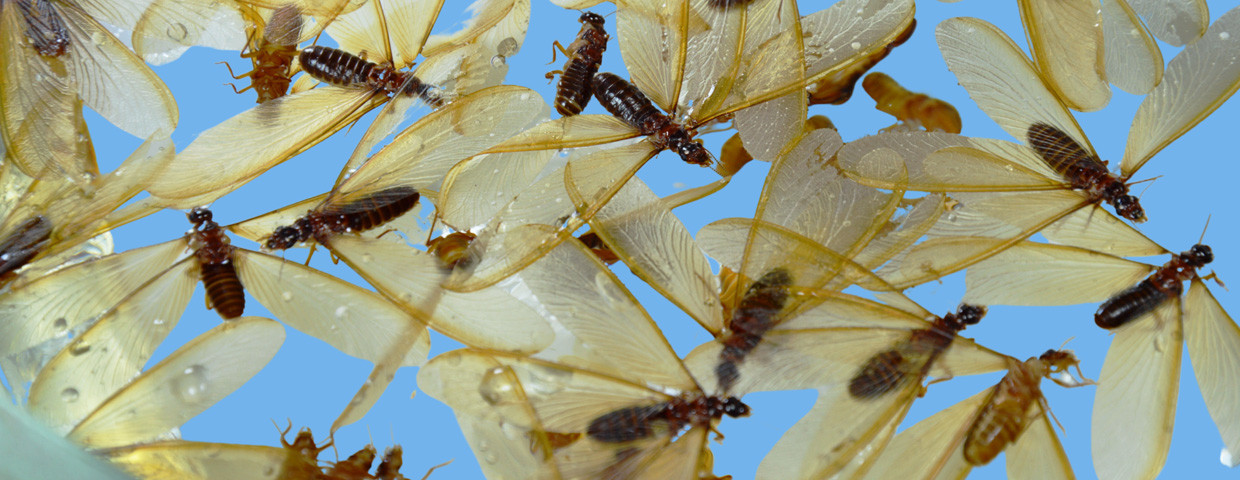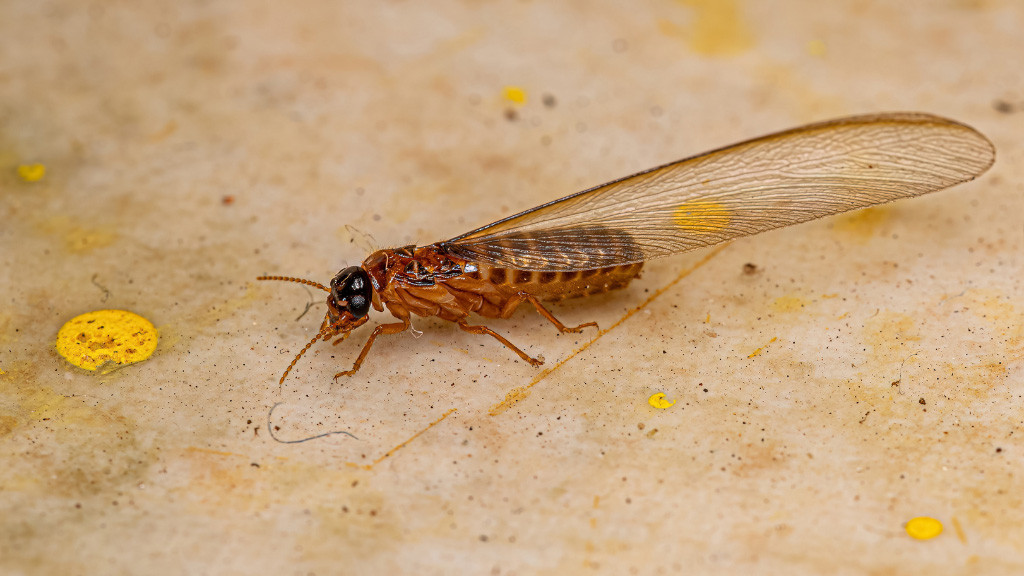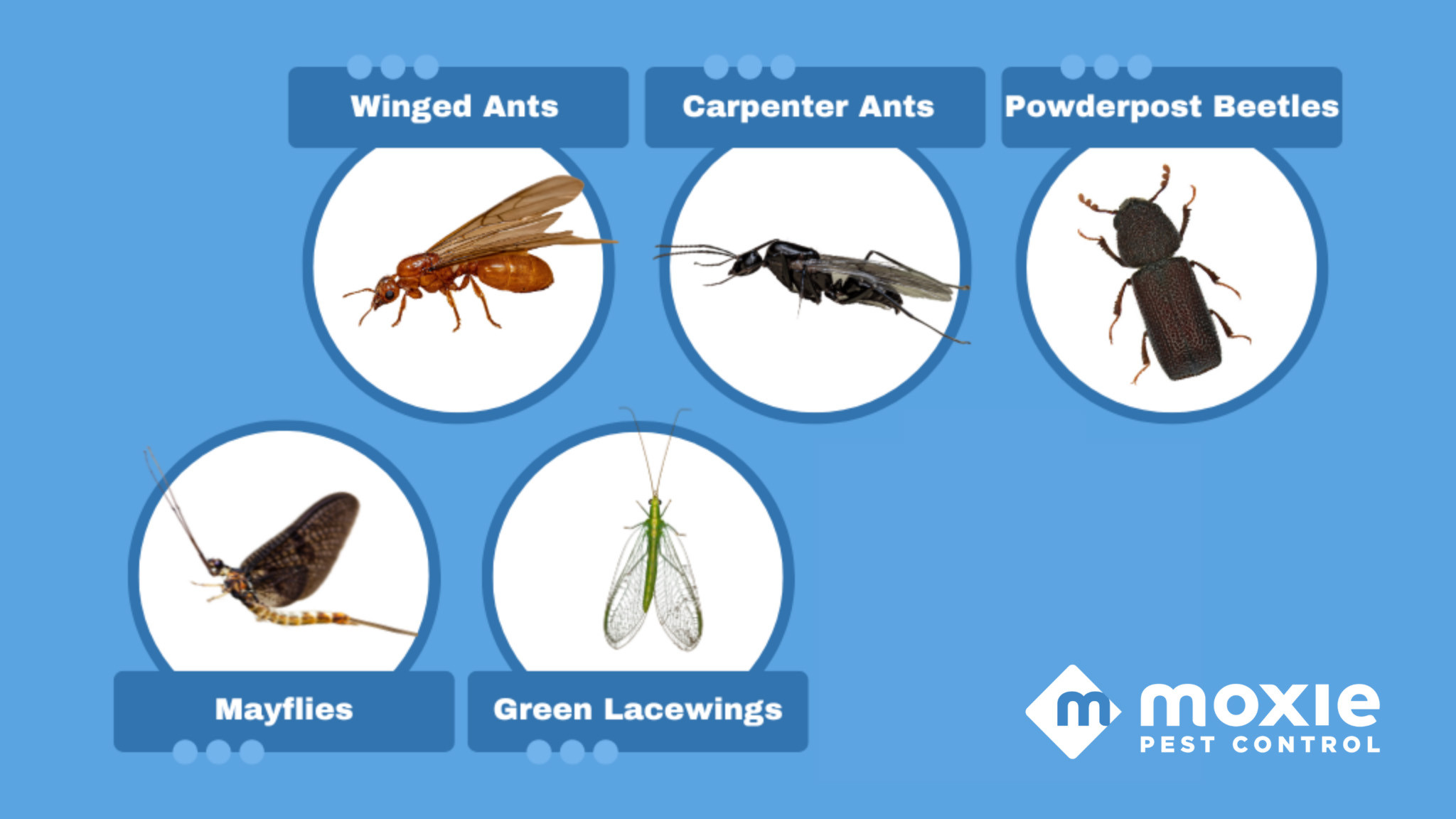Flying termites, scientifically known as alates (order Isoptera), are often mistaken for other flying insects. These small, yellowish-brown insects with smoky gray or brown wings are the reproductive members of termite colonies, and spotting them in your home can be a sign of a larger, hidden infestation. Typically measuring between ¼ to ⅜ inches in length, their presence warrants attention and potentially professional pest control intervention.
If you’ve noticed insects that resemble flying termites, it’s crucial to accurately identify them. Confusing termites with less harmful pests can lead to unnecessary stress, while misidentifying another pest as a termite could delay crucial treatment for a termite infestation. Termites can cause significant structural damage to homes by feeding on wooden structures, making prompt and accurate identification essential.
This guide will help you understand What Do Flying Termites Look Like and how to distinguish them from other common flying insects such as ants, lacewings, and beetles. Knowing the key characteristics of flying termites will empower you to determine if you need to contact pest control professionals like Moxie Pest Control for expert assistance.
 Flying Termite Identification
Flying Termite Identification
Key Characteristics of Flying Termites
Flying termites share some similarities with other insects, but several distinct features can help you identify them accurately. When asking yourself, “what do flying termites look like?”, focus on these key characteristics:
- Size and Color: Flying termites are generally ¼–¾ inches long. Their bodies are typically yellowish or brown, providing a somewhat pale appearance.
- Wings: A defining feature is their smoky gray or brown wings. They possess four wings of equal size, which are noticeably longer than their body. If you observe closely, you might even see veins within the wings.
- Antennae: Termite alates have straight, bead-like antennae. This is a crucial distinction from ants, which have elbowed antennae.
- Waist: Flying termites have a broad, thick waist, often described as a “chubby” waist. Unlike ants, their bodies do not have a pinched or constricted waist.
- Body: Termites, including winged termites, have soft bodies. This is another characteristic that differentiates them from some beetles, which have harder exoskeletons.
It’s also important to remember that termites are social insects. If you spot one flying termite, there’s a high probability that more are present, possibly indicating a colony nearby. You might see them in groups, sometimes alongside non-winged termites within a colony.
While most flying termites share these general characteristics, there are slight variations among different types of termites, such as subterranean, drywood, and Formosan termites. These variations are mostly in the wing venation and structure, which are details often used by entomologists for species identification.
- Subterranean Termites: These termites typically have smoky wings with two prominent veins. The cells (sections) on their wings are often square or rectangular in shape.
- Drywood Termites: Drywood termites have wings with three heavy veins. Their wing cells are more trapezoidal in shape.
- Formosan Termites: Formosan termites are distinguished by their hairy wings, setting them apart from other termite species.
The body color of most termites ranges from yellow, white, gray, to brown, although some species can also be black.
 Close up of Flying Termites
Close up of Flying Termites
Habitat and Behavior of Termites
Understanding where flying termites live and how they behave can also aid in identification and understanding the extent of a potential problem.
Termite habitats vary depending on the species. Subterranean termites, as their name suggests, typically nest in the soil. However, they can extend their reach into wooden structures above ground. Drywood termites, conversely, live directly within dry wood and establish their nests within wooden items or structures.
Subterranean termites are known for constructing mud tubes or tunnels. These tubes are made from a mixture of soil, saliva, and wood and serve as protected pathways for termites to travel between their nest and food sources. You might observe these tubes climbing along a home’s foundation walls. These mud tubes help maintain a moist environment for the termites as they forage.
Drywood termites, nesting directly in wood, can be more challenging to detect. They can live inside walls or wooden furniture without showing immediate external signs of infestation. This hidden nature of drywood termites can make early detection difficult.
It’s also worth noting that while flying termites (alates) are reproductive, they are not the only reproductive members in a termite colony. Secondary reproductive termites can exist within a colony and may not develop wings at all.
Insects Commonly Confused with Flying Termites
Many winged insects are mistaken for flying termites. While some of these insects can also be pests, many are harmless. Accurate identification is crucial before taking any action. If you are unsure, consulting pest control services is always recommended for proper identification and treatment if necessary.
Here are some insects that are frequently confused with flying termites:
-
Winged Ants: Winged ants are perhaps the most common insect mistaken for flying termites. Key differences include:
- Waist: Ants have a distinctly narrow, pinched waist, often described as hourglass-shaped, whereas termites have a thick waist.
- Antennae: Ant antennae are elbowed or bent, while termite antennae are straight and bead-like.
- Wings: Ants have uneven wings; their forewings are larger than their hindwings. Termites have four wings of equal size and length. Winged ants are commonly found outdoors and often congregate in high places when searching for mates.
-
Carpenter Ants: Carpenter ants are a type of winged ant that also nest in wood. They are larger than termites and can cause damage to wooden structures, similar to termites, although the type of damage is different. Carpenter ants create galleries in wood but do not consume the wood as termites do. They prefer damp or decaying wood for nesting.
-
Powderpost Beetles: These are wood-boring beetles that create small exit holes in wood and leave behind a fine, powdery dust, hence their name. While they infest wood like termites, they are beetles with hard bodies and different wing structures than termites. Powderpost beetles primarily attack hardwood.
-
Mayflies: Mayflies are short-lived insects often found near water sources. They have short, bristle-like antennae and long, thread-like tails. Their wing venation and body shape are quite different from termites upon closer inspection. Adult mayflies do not feed and are mainly focused on reproduction.
-
Green Lacewings: Green lacewings are light green insects with delicate, transparent wings characterized by a net-like venation pattern. They are often found in temperate and tropical regions and are generally solitary insects. Lacewings are beneficial insects as they often feed on aphids and other small insects. Adult lacewings may feed on nectar or pollen.
 Winged Ants vs Flying Termites
Winged Ants vs Flying Termites
When to Call Professionals for Termite Control
If you are seeing insects that you suspect are flying termites, or if you are uncertain about identification, it is always prudent to seek professional help. A termite infestation can be a serious issue for homeowners, potentially leading to costly structural repairs if left untreated.
Pest control professionals, like the experts at Moxie Pest Control, are trained to accurately identify pests and determine the best course of action. They can confirm whether you are dealing with termites or another type of insect. If termites are present, they can assess the extent of the infestation and recommend appropriate treatment options to eliminate the termites and protect your property.
Don’t let the worry of potential pests disrupt your peace of mind. Contacting professionals ensures accurate identification and effective solutions, helping you maintain a comfortable and safe home. For expert assistance with pest identification and control, reach out to Moxie Pest Control today for a free quote and reclaim your peace of mind.
Sources
https://www.learnaboutnature.com/insects/ants/flying-ants/
https://www.thespruce.com/controlling-the-winged-carpenter-ant-2656698
https://entomology.ca.uky.edu/ef616
https://texasinsects.tamu.edu/green-lacewing/
https://www.britannica.com/animal/mayfly
https://www.beebetternaturally.com/blog/2020/8/23/green-lacewings-in-the-bee-better-naturally-teaching-garden
https://texasinsects.tamu.edu/termite/
Author Bio
Courtney Enzor has worked in the pest control industry for about a decade. From helping you build a fly trap to giving you the best tips for identifying various bugs, she loves answering all your pest-related questions and sharing her pest-related expertise through writing. At the end of the day, she hopes her content will help people avoid mishaps and keep families happy and healthy!